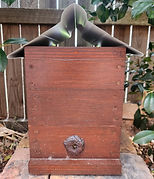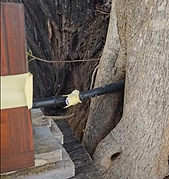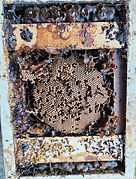After removal
After removal, we monitor the native bees progress, and utilise techniques like eduction to strengthen struggling colonies. This happens after the removal process.

New location
The hive is placed in a suitable location which has been handpicked for its location. The container holding the native bees which were vacuumed is connected to the new hive. Over the next few hours, they will find their way back into their new native bee hive.

Growth & Monitoring
The native bees are monitored for growth and colony strength. If the hive struggles to grow, a process called eduction or budding may be used. This involves connecting a strong, established hive to the back of the rescued hive. The native bees from the strong hive are forced to enter and exit through the rescued hive, providing much-needed support. Some native bees choose to permanently join the rescued colony, boosting its strength.

Strong hive
After 12-18 months, the relocated hive should be strong and healthy. At this point, it can be used for various purposes, such as pollination, honey or as pets. Whatever the reason, these healthy native bees play a vital role in our local ecosystem.
